Centrifuge Modelling of the Impact of Excavation with Partition Piles on Adjacent Existing Tunnel
Abstract
:1. Introduction
2. Design of the Centrifuge Modelling
2.1. Description of the Test
2.2. Model Preparation
2.2.1. Preparation of Soil
2.2.2. Arrangement of Structural Components
2.2.3. Heavy Liquid Discharge System
2.2.4. Sensor Arrangement
2.3. Testing Procedure
- (1)
- Begin by preparing the foundation soil, arranging the structural components, and installing the sensors, making sure to create the necessary space for the excavation.
- (2)
- Place the heavy liquid bag in the excavation and ensure that the discharge outlet is properly sealed. Then, pour the heavy liquid into the bag.
- (3)
- Commence the centrifuge, gradually ramping up to 50× g. Once the data from diverse sensors stabilizes, activate the electromagnetic valve to commence the discharge of the heavy liquid.
- (4)
- After the completion of excavation and upon the stabilization of sensor data, record the data and halt the centrifuge.
3. Results and Discussion
3.1. Horizontal Displacement of Retaining Wall
3.2. Ground Surface Settlement behind Retaining Wall
3.3. Displacement of Tunnel
3.4. Convergence Deformation of Tunnel
3.5. Induced Strain in Circular Direction of Existing Tunnel
4. Summary and Conclusions
- (1)
- The horizontal displacement of the retaining wall exhibited a cantilever-type displacement. In the control group, The horizontal displacement at the wall’s top section was approximately 1.04% times the excavation depth. After adding partition piles, the maximum horizontal displacement decreased by up to 10.6%.
- (2)
- The ground settlement behind the wall exhibited its maximum intensity in the immediate proximity to the retaining wall, gradually diminishing with the increasing distance from the retaining structure. In the control group, the maximum ground settlement reached 1.1% times the excavation depth. The addition of partition piles reduced ground settlement near the wall by up to 40.1%.
- (3)
- The complete deformation of the tunnel exhibited an approximate horizontal elliptical distortion, where the greatest horizontal displacement transpired at the right shoulder of the tunnel, and the maximum vertical displacement unfolded at the right arch of the tunnel. The introduction of partition piles resulted in a 36.7% reduction in the maximum horizontal displacement and a 31.8% decrease in the maximum vertical displacement of the tunnel.
- (4)
- The impact of partition pile parameters on the control efficacy of retaining wall displacement, ground surface settlement, and tunnel rigid displacement was broadly consistent. Increasing the length of the piles led to a deterioration of the control effect. The control effectiveness of partition piles could be further enhanced by increasing the top burial depth of the piles, but when it was too large and exceeded its critical value, the improvement effect of the top burial depth of piles on partition piles diminished.
- (5)
- In view of the effectiveness of the partition pile in controlling tunnel deformation mentioned above, further research should be conducted to optimize the control effect of the partition pile. Finding the optimal solution of the top burial depth of the pile in the subsequent studies will be a key direction. This will facilitate a deeper exploration of the mechanisms underlying the deformation control effects of partition piles concerning pile length and top burial depth of the pile. Subsequently, numerical simulations will be conducted to draw the deformation control zones of partition piles under various conditions. It will have positive implications for future excavation projects near existing tunnels.
Author Contributions
Funding
Institutional Review Board Statement
Informed Consent Statement
Data Availability Statement
Conflicts of Interest
References
- Wang, F.; Zhang, D.M.; Zhu, H.H.; Huang, H.W.; Yin, J.H. Impact of overhead excavation on an existing shield tunnel: Field monitoring and a full 3D finite element analysis. Cmc-Comput. Mater. Con. 2013, 34, 63–81. [Google Scholar]
- Sun, H.S.; Chen, Y.D.; Zhang, J.H.; Kuang, T.S. Analytical investigation of tunnel deformation caused by circular foundation pit excavation. Comput. Geotech. 2019, 106, 193–198. [Google Scholar] [CrossRef]
- Liang, R.Z.; Wu, J.; Sun, L.W.; Shen, W.; Wu, W.B. Performances of adjacent metro structures due to zoned excavation of a large-scale basement in soft ground. Tunn. Undergr. Space Technol. 2021, 117, 104123. [Google Scholar] [CrossRef]
- Guo, P.P.; Liu, F.F.; Lei, G.; Li, X.; Zhu, C.W.; Wang, Y.X.; Lu, M.M.; Cheng, K.; Gong, X.N. Predicting response of constructed tunnel to adjacent excavation with dewatering. Geofluids 2021, 2021, 5548817. [Google Scholar] [CrossRef]
- Huang, X.; Schweiger, H.F.; Huang, H.W. Influence of deep excavations on nearby existing tunnels. Int. J. Geotech. 2013, 13, 170–180. [Google Scholar] [CrossRef]
- Gao, G.Y.; Gao, M.; Yang, C.B.; Yu, Z.S. Influence of deep excavation on deformation of operating metro tunnels and countermeasures. Chin. J. Geotech. Eng. 2010, 32, 453–459. [Google Scholar]
- Hu, Z.F.; Yue, Z.Q.; Zhou, J.; Tham, L.G. Design and construction of a deep excavation in soft soils adjacent to the Shanghai Metro tunnels. Can. Geotech. J. 2003, 40, 933–948. [Google Scholar] [CrossRef]
- Chang, C.T.; Sun, C.W.; Duann, S.W.; Hwang, R.N. Response of a taipei rapid transit system (TRTS) tunnel to adjacent excavation. Tunn. Undergr. Space Technol. 2001, 16, 151–158. [Google Scholar] [CrossRef]
- Doležalová, M. Tunnel complex unloaded by a deep excavation. Comput. Geotech. 2001, 28, 469–493. [Google Scholar] [CrossRef]
- Ng, C.W.W.; Shi, J.W.; Chen, Y.H. Three-dimensional centrifuge modelling of basement excavation effects on an existing tunnel in dry sand. Can. Geotech. J. 2013, 50, 874–888. [Google Scholar] [CrossRef]
- Huang, X.; Huang, H.W.; Zhang, D.M. Centrifuge modelling of deep excavation over existing tunnels. Proc. Inst. Civ. Eng.-Geotech. Eng. 2014, 167, 3–18. [Google Scholar] [CrossRef]
- Chen, R.P.; Liu, S.L.; Meng, F.Y.; Ye, J.N.; Zhu, B. Centrifuge modelling of excavation effects on a nearby tunnel in soft clay. Chin. J. Geotech. Eng. 2020, 42, 1132–1138. [Google Scholar]
- Sharma, J.S.; Hefny, A.M.; Zhao, J.; Chan, C.W. Effect of large excavation on deformation of adjacent MRT tunnels. Tunn. Undergr. Space Technol. 2001, 16, 93–98. [Google Scholar] [CrossRef]
- Shi, J.W.; Fu, Z.Z.; Guo, W.L. Investigation of geometric effects on three-dimensional tunnel deformation mechanisms due to basement excavation. Comput. Geotech. 2019, 106, 108–116. [Google Scholar] [CrossRef]
- Shi, J.W.; Ng, C.W.W.; Chen, Y.H. Three-dimensional numerical parametric study of the influence of basement excavation on existing tunnel. Comput. Geotech. 2015, 63, 146–158. [Google Scholar] [CrossRef]
- Zhang, Z.G.; Huang, M.S.; Wang, W.D. Evaluation of deformation response for adjacent tunnels due to soil unloading in excavation engineering. Tunn. Undergr. Space Technol. 2013, 38, 244–253. [Google Scholar] [CrossRef]
- Zhang, H.B.; Chen, J.J.; Fan, F.; Wang, J.H. Deformation monitoring and performance analysis on the shield tunnel influenced by adjacent deep excavations. J. Aerospace. Eng. 2017, 30, B4015002. [Google Scholar] [CrossRef]
- Shi, C.H.; Cao, C.Y.; Lei, M.F.; Peng, L.M.; Ai, H.J. Effects of lateral unloading on the mechanical and deformation performance of shield tunnel segment joints. Tunn. Undergr. Space Technol. 2016, 51, 175–188. [Google Scholar] [CrossRef]
- Shen, H.; Luo, X.Q.; Li, Y.; Pang, B.; Yang, D.C. Numerical simulation and analysis of influence of deep excavation on adjacent subway station. Chin. J. Geotech. Eng. 2011, 7, 1018–1023, 1028. [Google Scholar]
- Meissner, S.; Kies, M.; Berger, A. Complex excavation and foundation variants in a subway protection zone in Frankfurt. Geotechnik 2023, 46, 38–47. [Google Scholar]
- Ng, C.W.W.; Shi, J.W.; Masin, D.; Sun, H.S.; Lei, G.H. Influence of sand density and retaining wall stiffness on three-dimensional responses of tunnel to basement excavation. Can. Geotech. J. 2015, 52, 1811–1829. [Google Scholar] [CrossRef]
- Diao, Y.; Li, P.J.; Huang, J.Y.; Liu, S.; Guo, X.; Hu, Q.S. Effects of environmental factors on mechanical properties of biomimetic mineralized mortar. J. Build. Eng. 2023, 66, 105850. [Google Scholar] [CrossRef]
- Diao, Y.; Yang, C.; Huang, J.Y.; Liu, S.; Guo, X.; Pan, W.Q. Preparation and solidification mechanism of biomimetic mineralized cement using L-Asp as crystal modifier. J. Mater. Res. Technol. 2023, 24, 7756–7770. [Google Scholar] [CrossRef]
- Huang, J.Y.; Diao, Y.; Zheng, G.; Su, Y.M.; Wang, M.H.; Pan, W.Q.; Chen, H. Horizontal Deformation Efficiency of a Pile Controlled by the Capsuled Expansion Technique: A Field Trial and Numerical Analysis. Int. J. Geomech. 2024, 24, 04023262. [Google Scholar] [CrossRef]
- Wu, H.N.; Lan, G.Z.; Liu, Y.; Chen, R.P.; Meng, F.Y.; Xu, X.P. Field performance of an anti-uplift portal frame in control of the tunnel uplift induced by overlying excavation. Tunn. Undergr. Space Technol. 2023, 132, 104908. [Google Scholar] [CrossRef]
- Asano, T.; Ishihara, M.; Kiyota, Y.; Kurosawa, H.; Ebisu, S. An observational excavation control method for adjacent mountain tunnels. Tunn. Undergr. Space Technol. 2003, 18, 291–301. [Google Scholar] [CrossRef]
- Zhao, Y.R.; Chen, X.S.; Hu, B.; Wang, P.H.; Li, W.S. Evolution of tunnel uplift induced by adjacent long and collinear excavation and an effective protective measure. Tunn. Undergr. Space Technol. 2023, 131, 104846. [Google Scholar] [CrossRef]
- Chen, R.P.; Meng, F.Y.; Li, Z.C.; Ye, Y.H.; Ye, J.N. Investigation of response of metro tunnels due to adjacent large excavation and protective measures in soft soils. Tunn. Undergr. Space Technol. 2016, 58, 224–235. [Google Scholar] [CrossRef]
- He, M.C.; Sui, Q.R.; Li, M.N.; Wang, Z.J.; Tao, Z.G. Compensation excavation method control for large deformation disaster of mountain soft rock tunnel. Int. J. Min. Sci. Technol. 2022, 32, 951–963. [Google Scholar] [CrossRef]
- Bilotta, E.; Russo, G. Use of a line of piles to prevent damages induced by tunnel excavation. J. Geotech. Geoenviron. Eng. 2011, 137, 254–262. [Google Scholar] [CrossRef]
- Ma, S.K.; Fu, X.X.; Lu, H.; Huang, Z.; Zhang, J.B. A combined support method of partition pile and diaphragm wall for protection of buildings adjacent to deep excavation. Arab. J. Geosci. 2021, 14, 2005. [Google Scholar] [CrossRef]
- Ying, H.W.; Li, T.; Yang, Y.W. Analysis on the effect and engineering application of protecting adjacent buildings with partition wall of deep excavation. Chin. J. Geotech. Eng. 2011, 33, 1123–1128. [Google Scholar]
- Song, G.Y.; Marshall, A.M. Centrifuge study on the use of protective walls to reduce tunnelling-induced damage of buildings. Tunn. Undergr. Space Technol. 2021, 115, 104064. [Google Scholar] [CrossRef]
- Rampello, S.; Fantera, L.; Masini, L. Efficiency of embedded barriers to mitigate tunnelling effects. Tunn. Undergr. Space Technol. 2019, 89, 109–124. [Google Scholar] [CrossRef]
- Zheng, G.; Wang, F.J.; Du, Y.M.; Diao, Y.; Lei, Y.W.; Cheng, X.S. The efficiency of the ability of isolation piles to control the deformation of tunnels adjacent to excavations. Int. J. Civ. Eng. 2018, 16, 1475–1490. [Google Scholar] [CrossRef]
- Bilotta, E. Use of diaphragm walls to mitigate ground movements induced by tunnelling. Géotechnique 2008, 58, 143–155. [Google Scholar] [CrossRef]
- Chen, R.P.; Ashraf, A.; Meng, F.Y. Centrifuge model test study on the influence of excavation on side tunnel and the action of partition wall. Chin. J. Geotech. Eng. 2018, 40, 6–11. [Google Scholar]
- Zheng, G.; Du, Y.M.; Diao, Y. Optimization analysis of deformation control of existing tunnel outside excavation by partition pile. Chin. J. Rock Mech. Eng. 2015, 34, 3499–3509. [Google Scholar]
- Chen, R.P.; Meng, F.R.; Li, Z.C.; Ye, Y.H.; Hu, Q. Excessive displacement and protective measures of metro tunnel near deep excavation. J. Zhejiang Univ. 2016, 50, 856–863. [Google Scholar]
- Bai, Y.; Yang, Z.H.; Jiang, Z.W. Key protection techniques adopted and analysis of influence on adjacent buildings due to the Bund Tunnel construction. Tunn. Undergr. Space Technol. 2014, 41, 24–34. [Google Scholar] [CrossRef]
- Wang, B.Y.; Du, Y.M.; Diao, Y.; Zhao, X.Y. Numerical optimization of mini centrifuge modelling test design of excavation unloading influence on existing tunnel controlled by partition piles. Sustainability 2023, 15, 8353. [Google Scholar] [CrossRef]


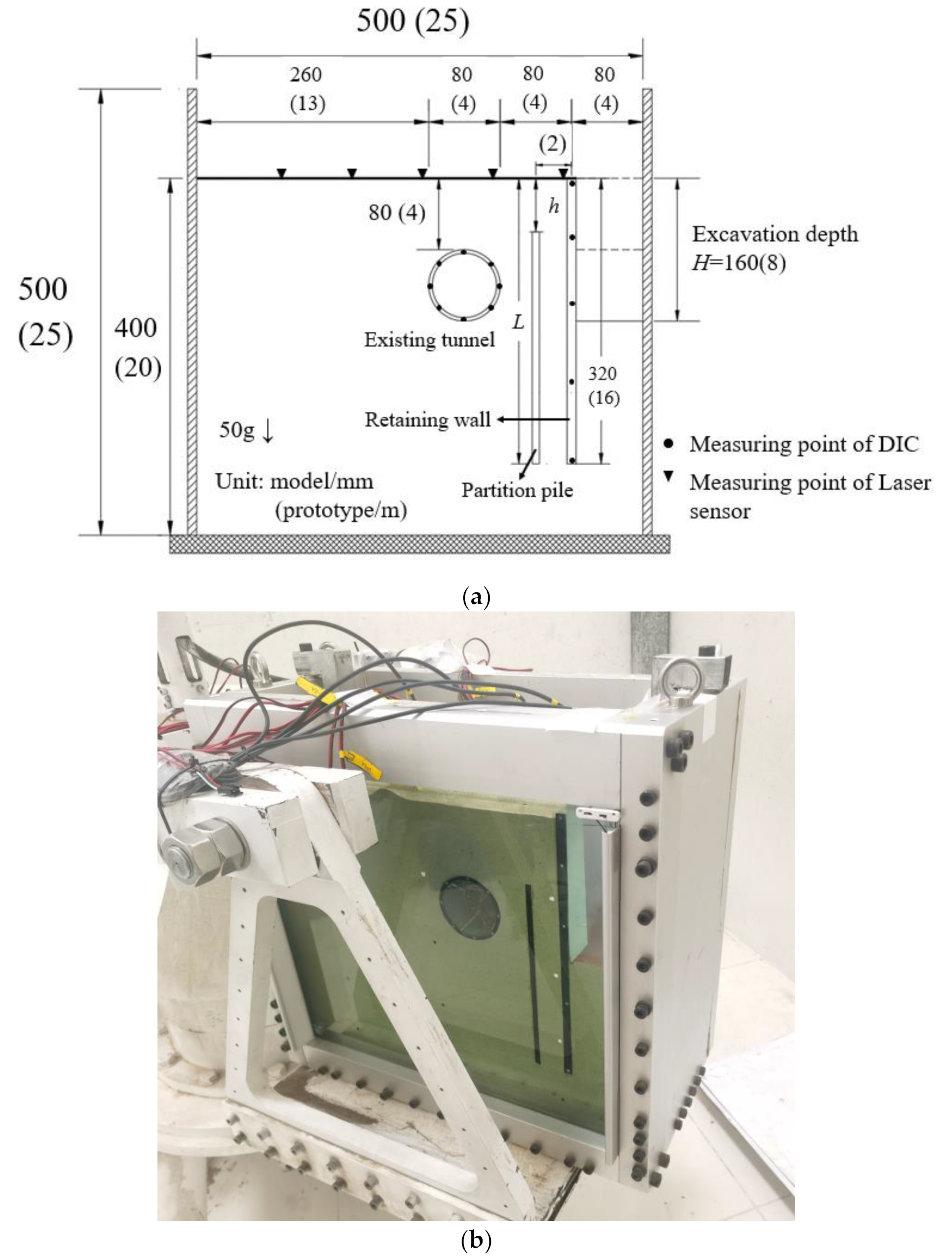
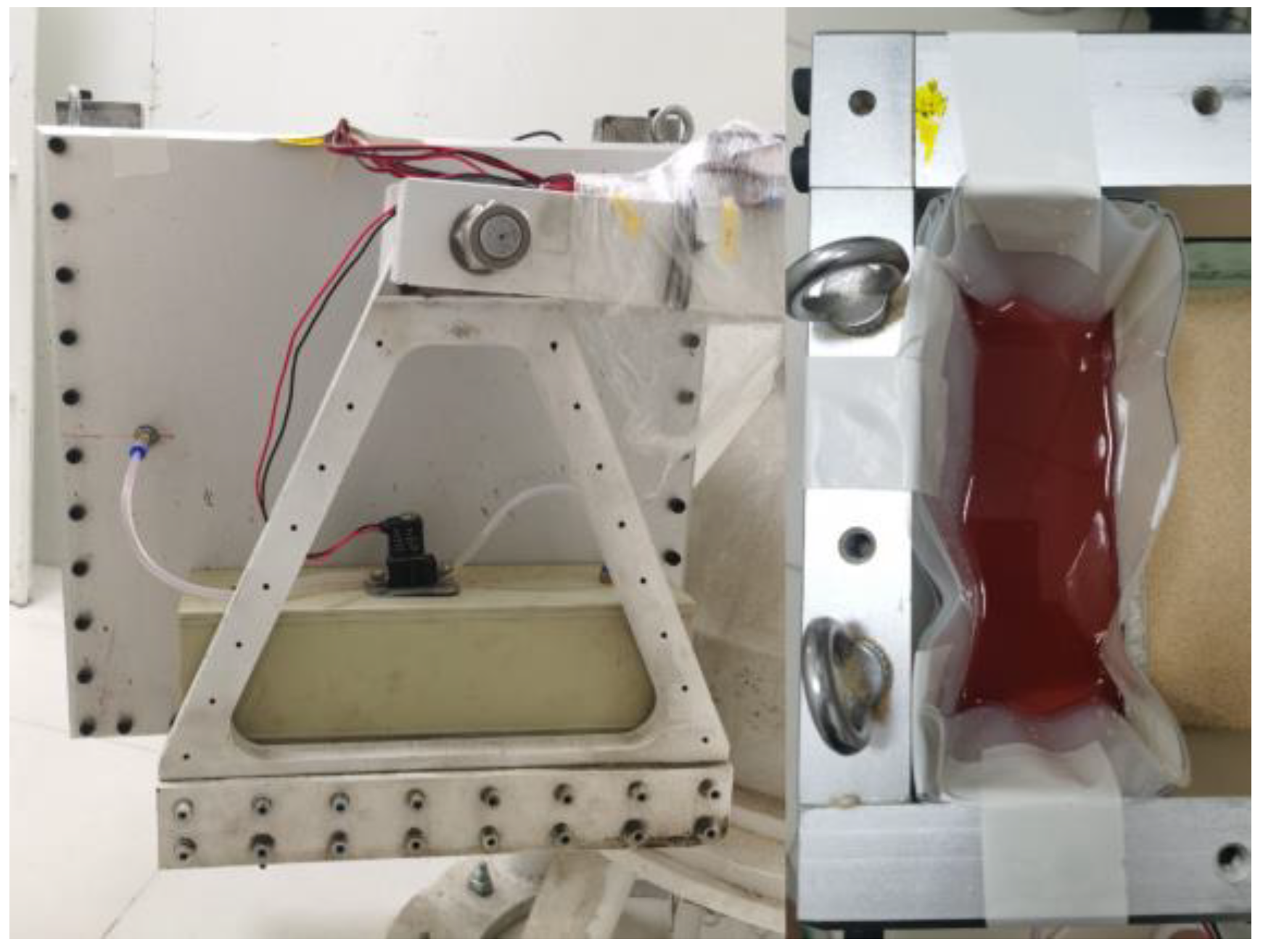
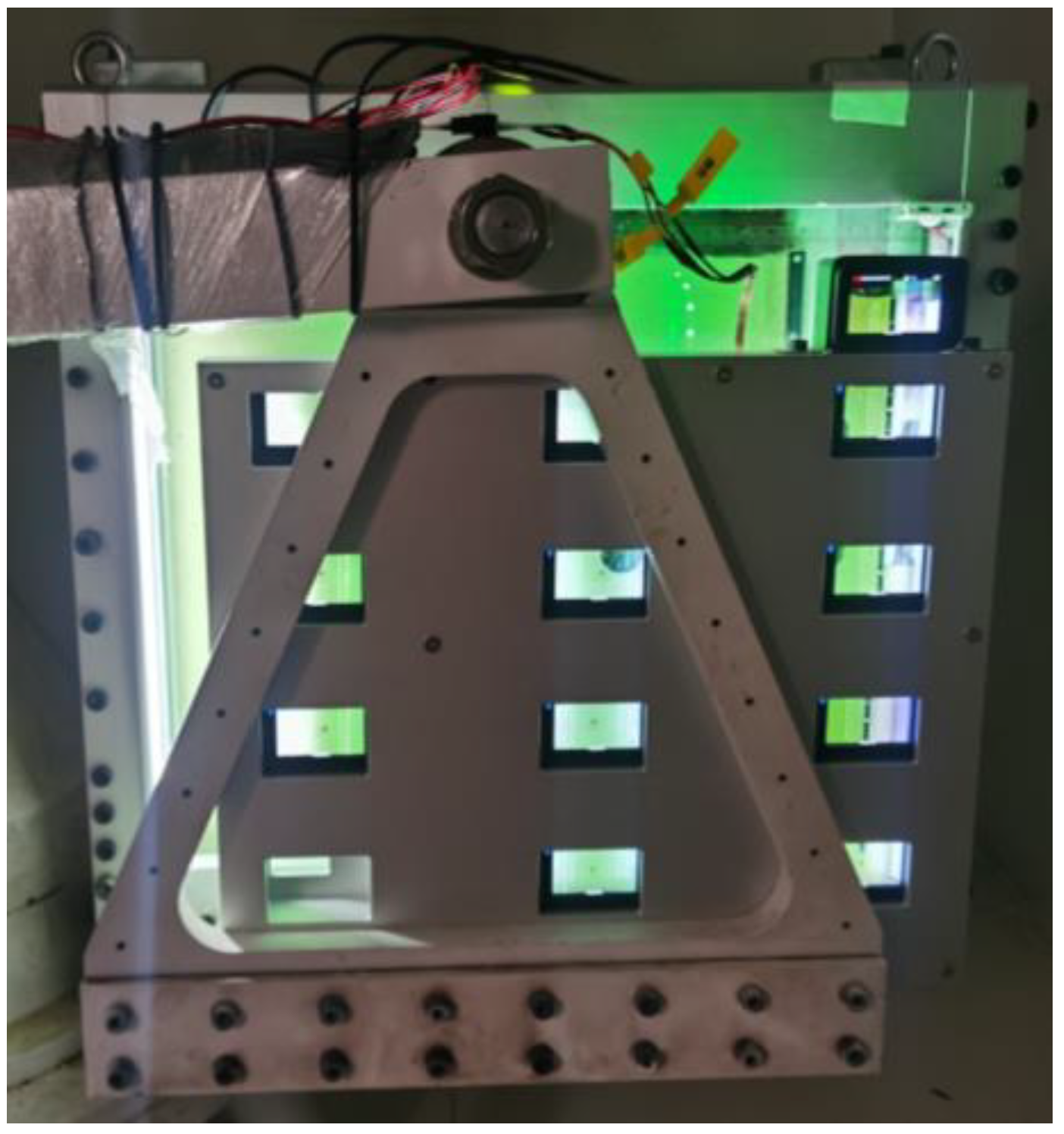
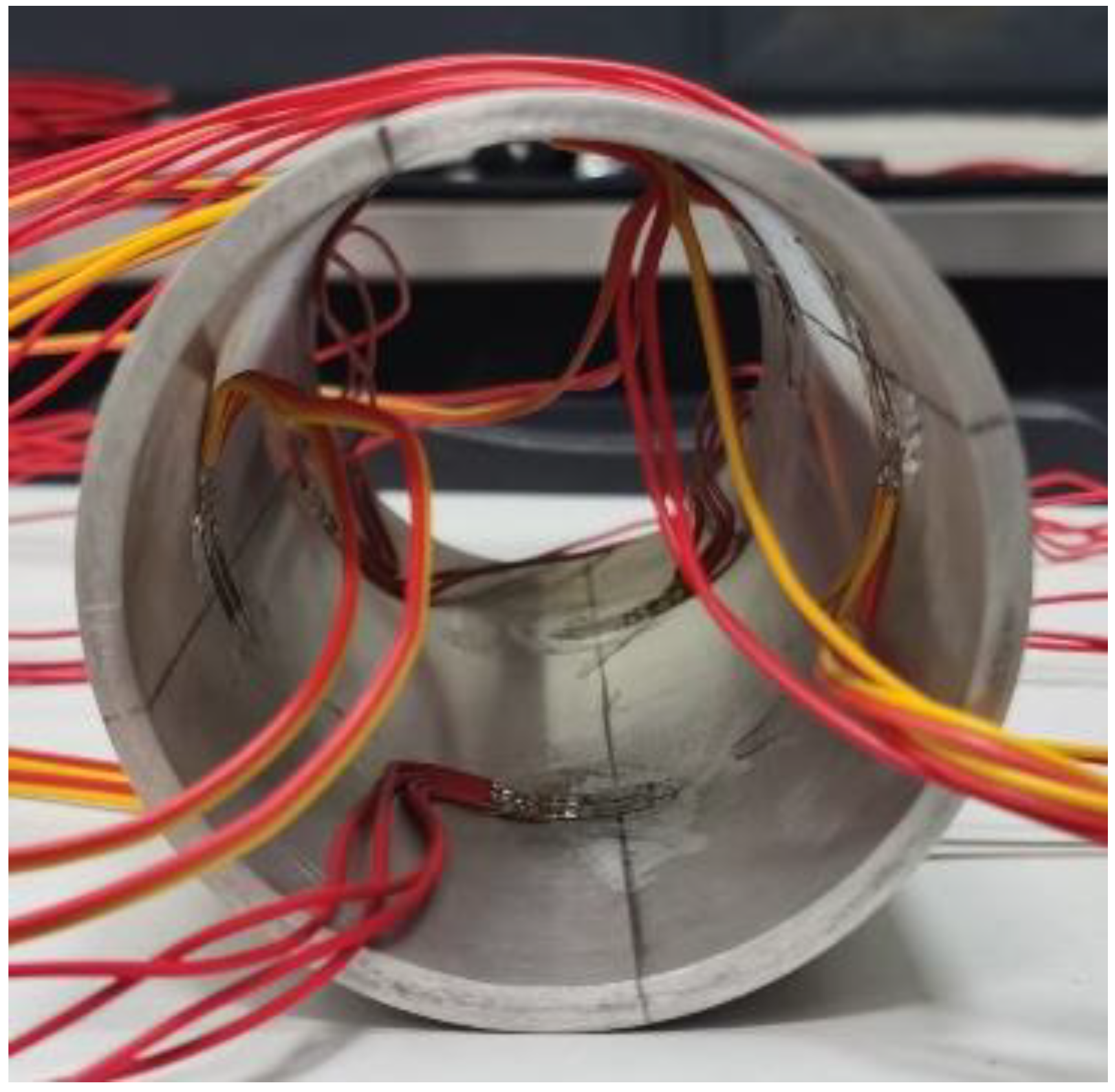
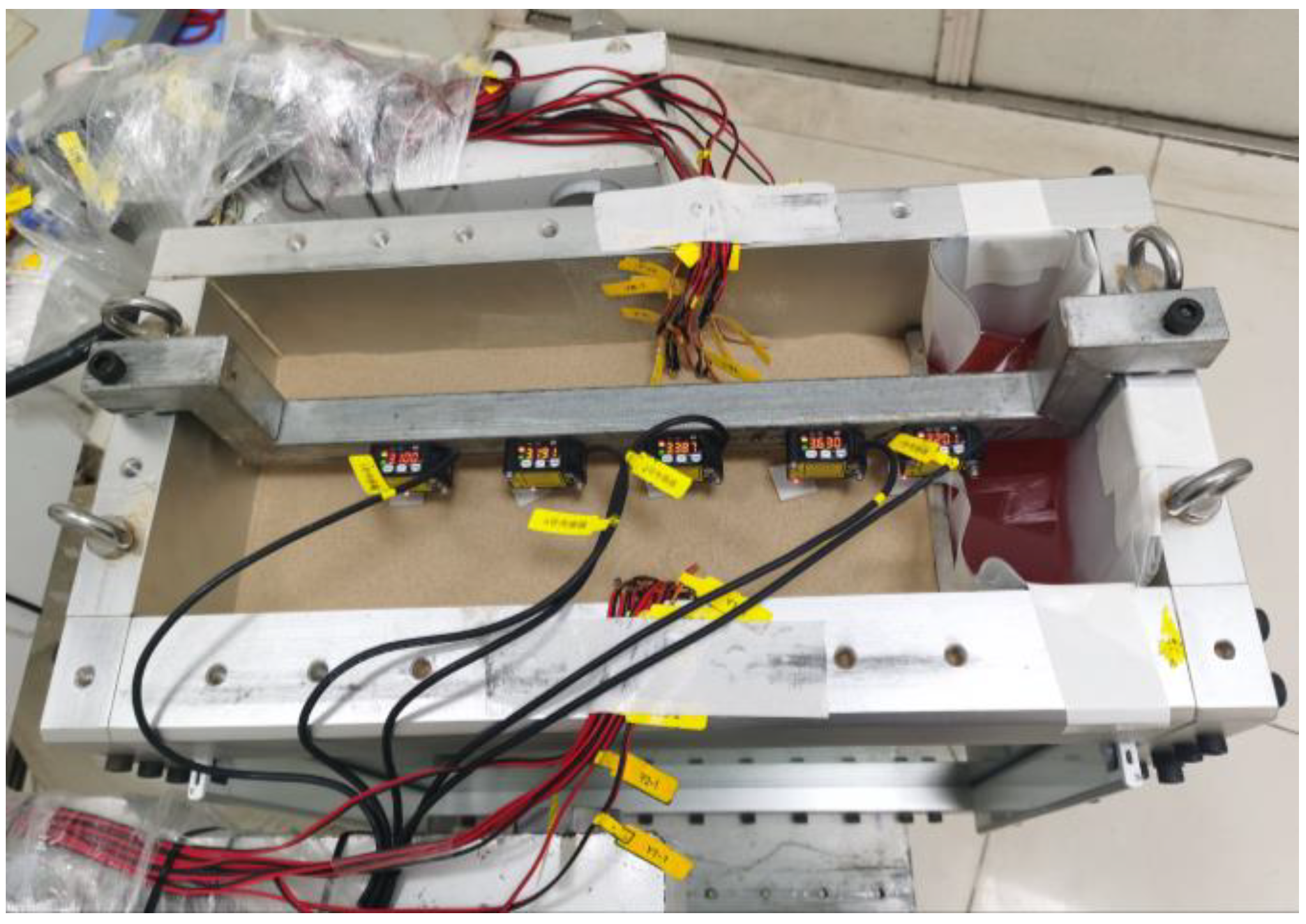
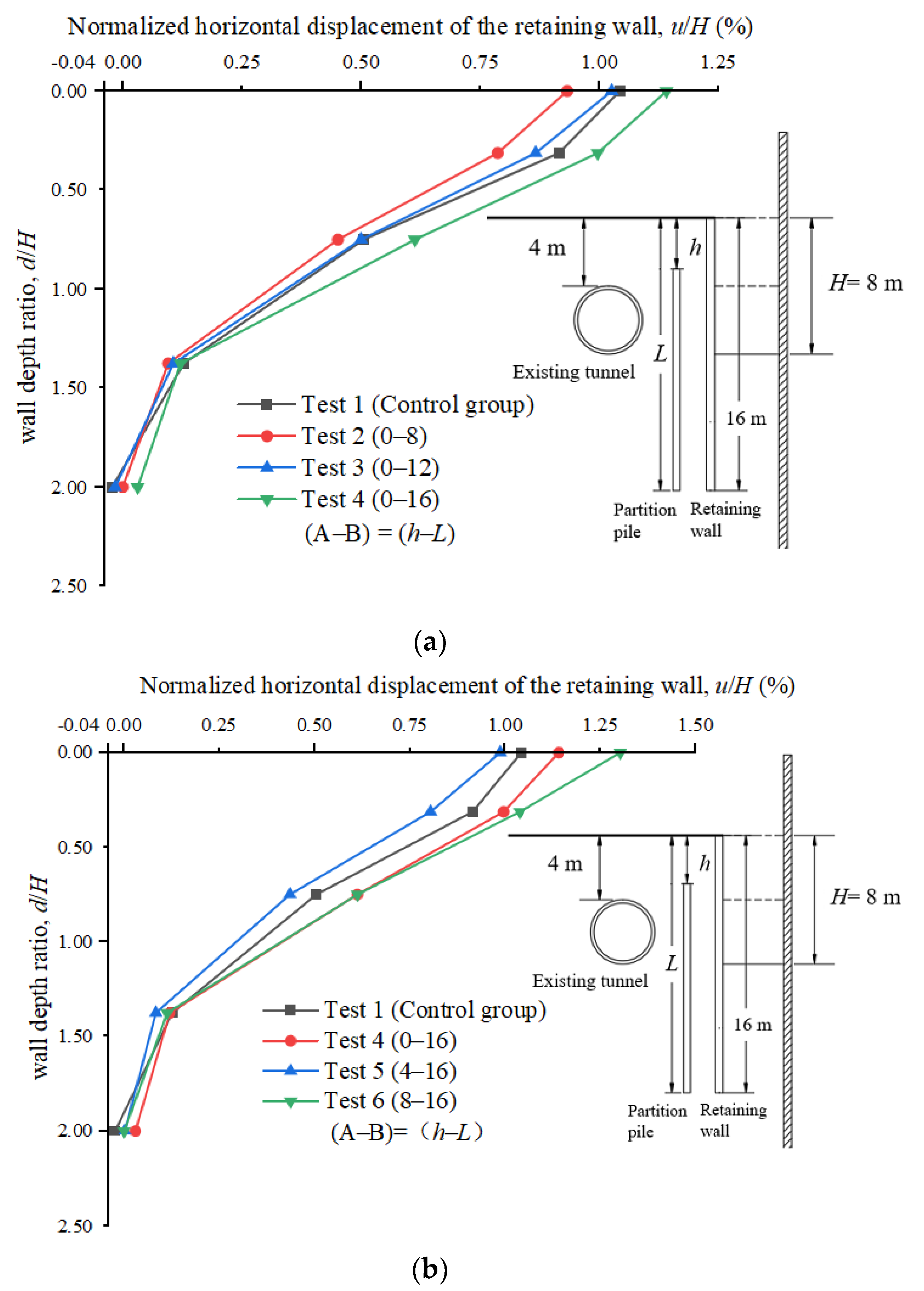




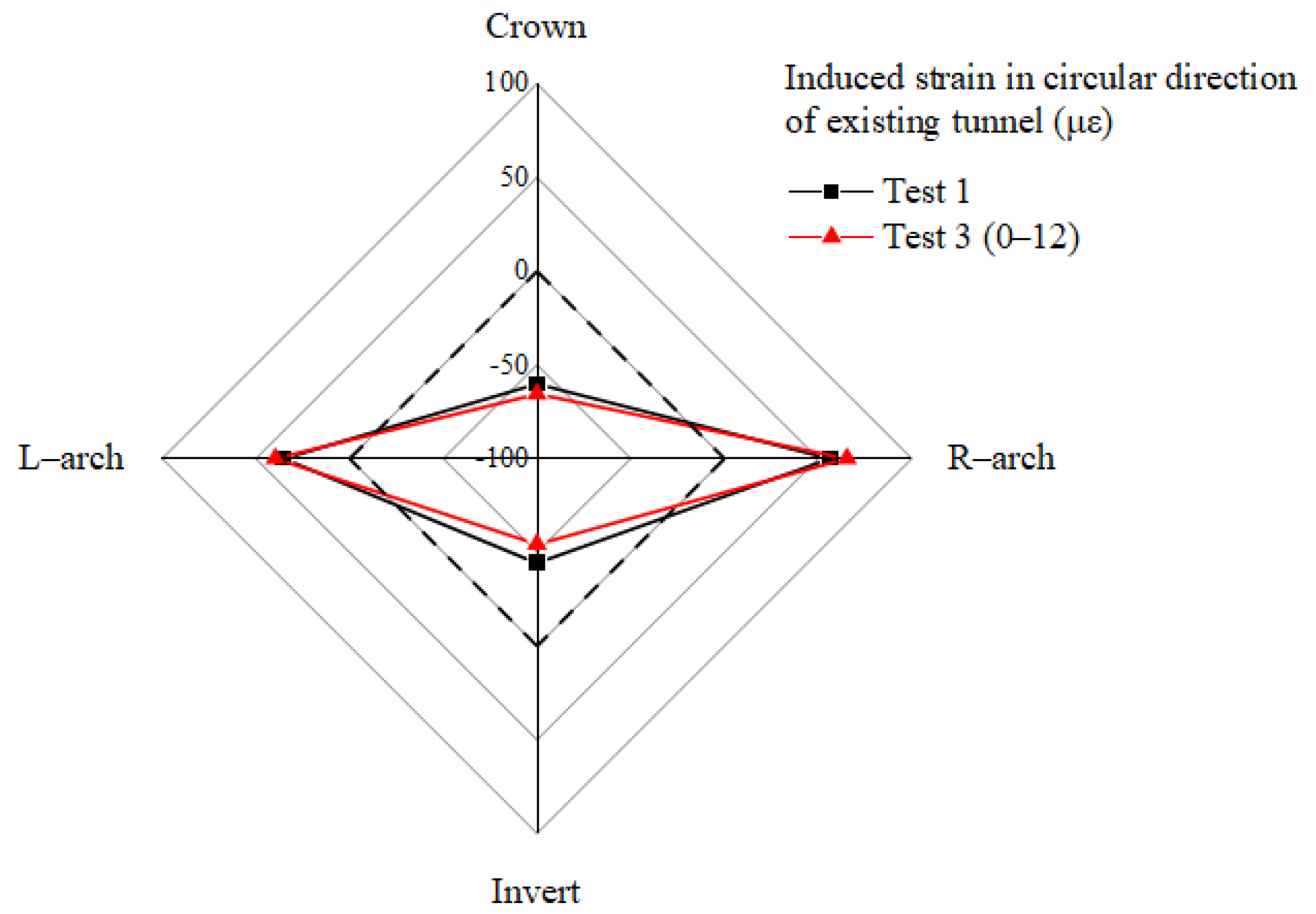
| Test Number | Length of Pile (L)/m | Top Burial Depth of Pile (h)/m |
|---|---|---|
| 1 (Control group) | 0 | 0 |
| 2 | 8 | 0 |
| 3 | 12 | 0 |
| 4 | 16 | 0 |
| 5 | 16 | 4 |
| 6 | 16 | 8 |
| Parameter | Symbol | Dimension | Similarity Ratio |
|---|---|---|---|
| Gravitational acceleration | g | L·T−2 | 50 |
| Geometric dimension | L | L | 1/50 |
| Displacement | D | L | 1/50 |
| Density | ρ | M·L−3 | 1 |
| Time | T | T | 1/502 |
| Strain | ε | - | 1 |
| Stress | σ | M·T−2·L−1 | 1 |
| Elastic modulus | E | M·T−2·L−1 | 1 |
| Bending stiffness | EI | M·T−2·L3 | 1/504 |
| Bending stiffness per unit length | EI | M·T−2·L2 | 1/503 |
| Bending moment | M | M·T−2·L2 | 1/503 |
| Bending moment per unit length | M | M·T−2·L | 1/502 |
| Structural Components | Parameters | Model Size (mm) | Prototype Size (m) |
|---|---|---|---|
| Retaining wall | Thickness | 10 | 0.5 |
| Length | 320 | 16 | |
| Width | 200 | 10 | |
| Tunnel | Outer Diameter | 80 | 4 |
| Thickness | 4 | 0.2 | |
| Width | 200 | 10 | |
| Partition wall | Thickness | 6 | 0.3 |
| Length | 160, 240, 320 | 8, 12, 16 | |
| Width | 200 | 10 |
Disclaimer/Publisher’s Note: The statements, opinions and data contained in all publications are solely those of the individual author(s) and contributor(s) and not of MDPI and/or the editor(s). MDPI and/or the editor(s) disclaim responsibility for any injury to people or property resulting from any ideas, methods, instructions or products referred to in the content. |
© 2023 by the authors. Licensee MDPI, Basel, Switzerland. This article is an open access article distributed under the terms and conditions of the Creative Commons Attribution (CC BY) license (https://creativecommons.org/licenses/by/4.0/).
Share and Cite
Du, Y.; Wang, B.; Diao, Y.; Zhao, H.; Zhao, X.; Su, Y. Centrifuge Modelling of the Impact of Excavation with Partition Piles on Adjacent Existing Tunnel. Appl. Sci. 2023, 13, 13064. https://doi.org/10.3390/app132413064
Du Y, Wang B, Diao Y, Zhao H, Zhao X, Su Y. Centrifuge Modelling of the Impact of Excavation with Partition Piles on Adjacent Existing Tunnel. Applied Sciences. 2023; 13(24):13064. https://doi.org/10.3390/app132413064
Chicago/Turabian StyleDu, Yiming, Bingyi Wang, Yu Diao, Haotian Zhao, Xiangyu Zhao, and Yiming Su. 2023. "Centrifuge Modelling of the Impact of Excavation with Partition Piles on Adjacent Existing Tunnel" Applied Sciences 13, no. 24: 13064. https://doi.org/10.3390/app132413064




